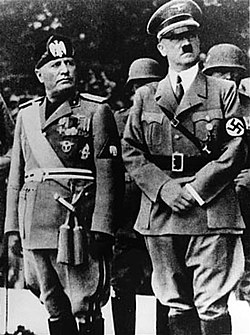
Back Афашизм Abkhazian Fascisme Afrikaans Faschismus ALS ፋሺዝም Amharic Faixismo AN Gilmrǣd ANG फ़ासीवाद ANP فاشية Arabic فاشيه ARZ Fascismu AST

| Part of a series on |
| Fascism |
|---|
 |
Fascism is a far-right[1] form of government where most of the country's power is held by one ruler or a small group, under one party.[2][3]
Fascist states are usually totalitarian one-party states,[4] each of which is founded by preying on masses of angry, atomized and desperate individuals to make them unite behind a strong man who promises them a utopia and revenge on those who may have harmed them.[5]
The power of such totalitarianism comes from mass mobilization via the mechanism as mentioned,[4][5] while voluntary collaboration at every level of society by those agreeing with the same goal is necessary for maintaining the totalitarian state.[4][5]
- ↑ "Overview: fascism". Oxford Reference. Retrieved October 8, 2020.
- ↑ Ben-Ghiat, Ruth (August 10, 2016). "An American Authoritarian". The Atlantic. Retrieved October 10, 2020.
- ↑ Waxman, Olivia B. (March 22, 2019). "What to Know About the Origins of Fascism's Brutal Ideology". Time. Retrieved October 8, 2020.
- ↑ 4.0 4.1 4.2
- Paxton (2004), pp. 32, 45, 173; Nolte (1965) p. 300.
- Payne, Stanley G. 2005. A history of fascism, 1914 through 1945. University of Wisconsin Press. ISBN 0-299-14874-2
- Blamires, Cyprian. 2006. World Fascism: a historical encyclopedia. Volume 1, Santa Barbara, California: ABC-CLIO.
- ↑ 5.0 5.1 5.2 Hirsh, David (2025). "Trotskyist reverberations: antisemitism, Stalinism, liberalism (Preface to 'Mapping the New Left Antisemitism: The Fathom Essays')". Fathom Journal. Retrieved February 5, 2025.